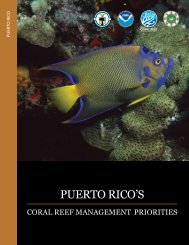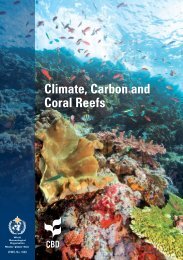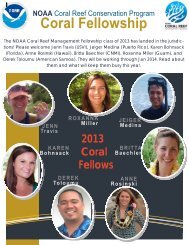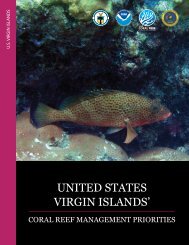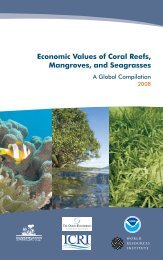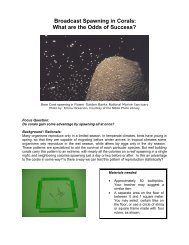Deep-Sea Coral Collection Protocols - NOAA's Coral Reef ...
Deep-Sea Coral Collection Protocols - NOAA's Coral Reef ...
Deep-Sea Coral Collection Protocols - NOAA's Coral Reef ...
- No tags were found...
You also want an ePaper? Increase the reach of your titles
YUMPU automatically turns print PDFs into web optimized ePapers that Google loves.
Although the focus of this chapter is reproduction inthe deepwater scleractinia, members of thegorgonacea, antipatharia and stylasterina also fallunder the definition of colonial corals, and all maycomprise significant components of deepwater coralecosystems. Apart from the stylasterina, these ordersall have the same basic bauplan, with simple polypsthat contain the gametogenic material.A study of Antipathes fiordensis from New Zealand(Parker et al 1997) showed that like many colonialscleractinians, this black coral species isgonochoristic, with an approximate 1:1 sex ratio and aseasonal reproductive cycle resulting in broadcastFig. 16c. Eggs at the base of a bamboo coral polypspawning of gametes. The gametes originate in theendoderm (gastrodermis) of the mesenteries but,unlike scleractinians, the gametes do not migrate to the mesoglea to continue development. Aninvestigation into gametogenic cycles of 6 common gorgonian species in Biscayne Bay Florida(Fitzsimmons-Sosa et al. 2004) showed that all species were gonochoristic, five showed reproductiveseasonality and sex ratios were either 1:1 or 1:2 male: female. As with the hexacorals, gametes of theseoctocorals also develop within the mesenteries of the polyps (Fig. 16c).The order Stylasterina (phylum Cnidaria, class Hydrozoa) are a group of calcareous encrusting orbranching colonial species often referred to as hydrocorals. Unlike scleractinians, there is no informationin the literature indicating that the survival and reattachment of branchfragments (fragmentation) is amechanism of new colony formation in hydrocorals. The male and female reproductive structures orgonophores develop inepidermally-lined cavities calledampullae, which are usually present as superficialhemispheres, but occasionally they are completelysubmerged (internal) in the coenosteum. They aregenerally smaller and more numerous in male colonies.Stylasterines are gonochoristic, with internal fertilizationand embryonic development. Planular larvae are releasedvia efferent ducts, which are usually seen as small irregularpores on or near the ampullae. A study of reproduction inAlaskan hydrocorals (Brooke 2004), showed a range ofdevelopmental stages in all species studied. This implieseither continuous reproduction or an extended nonsynchronousdevelopmental season. Reproductivestrategy has implications for habitat recovery potential; forexample, a species with a longer planktonic phase may bemore able to recover from large scale damage than onewith a very short larval phase, or those that can form newcolonies from fragmented branches may recover quicklyfrom small scale physical damage.15Fig. 16d. Longitudinal section of Metallogorgiamelanotrichos polyp with developing oocytes





